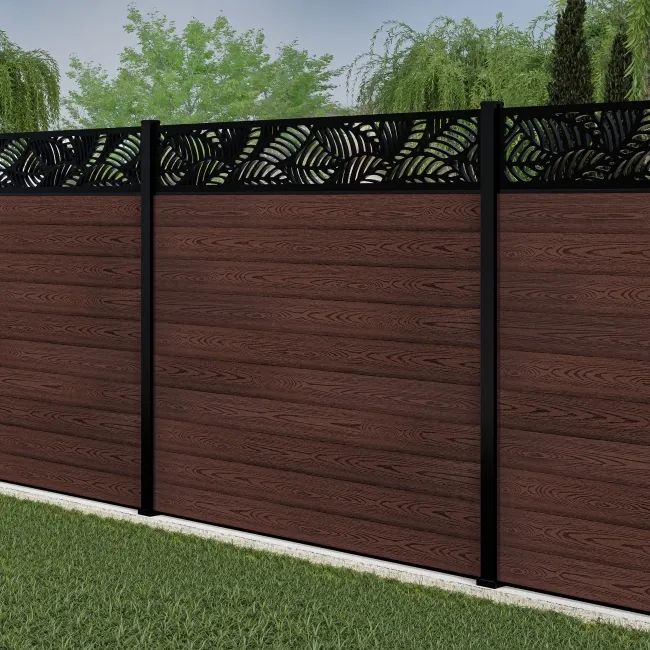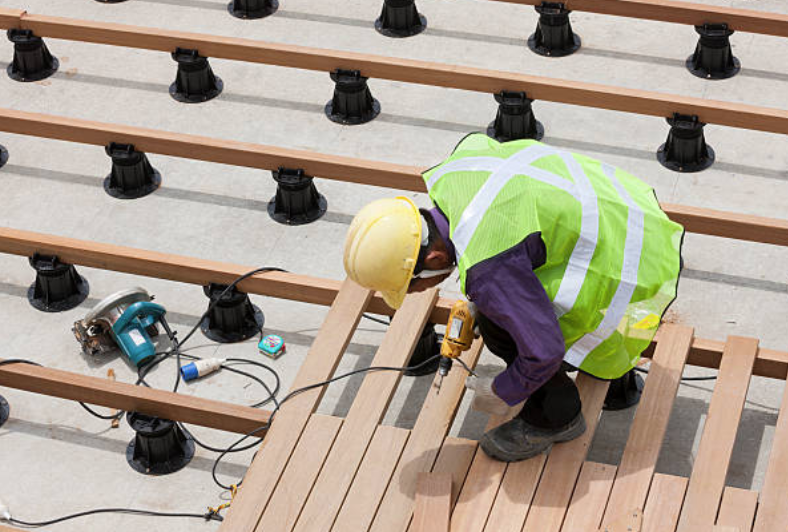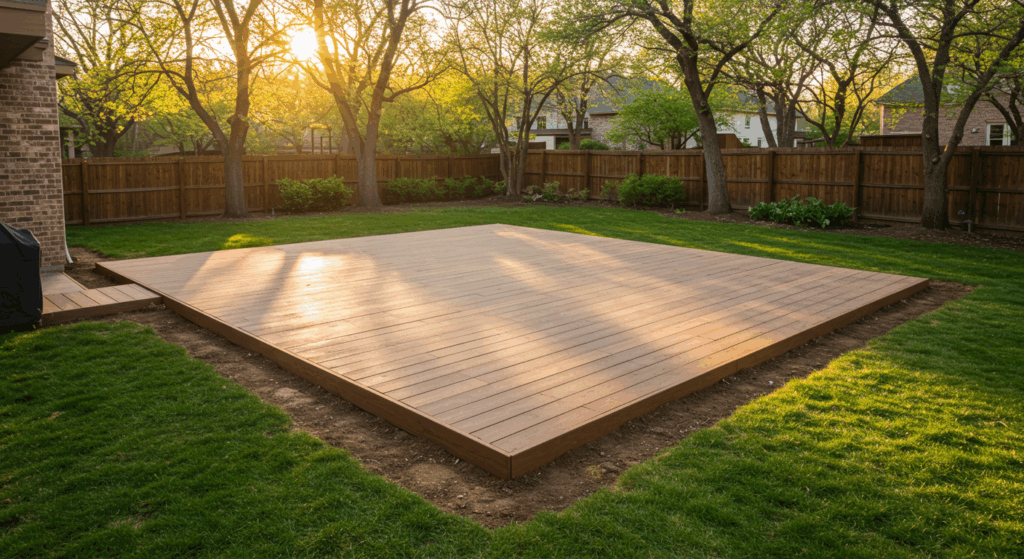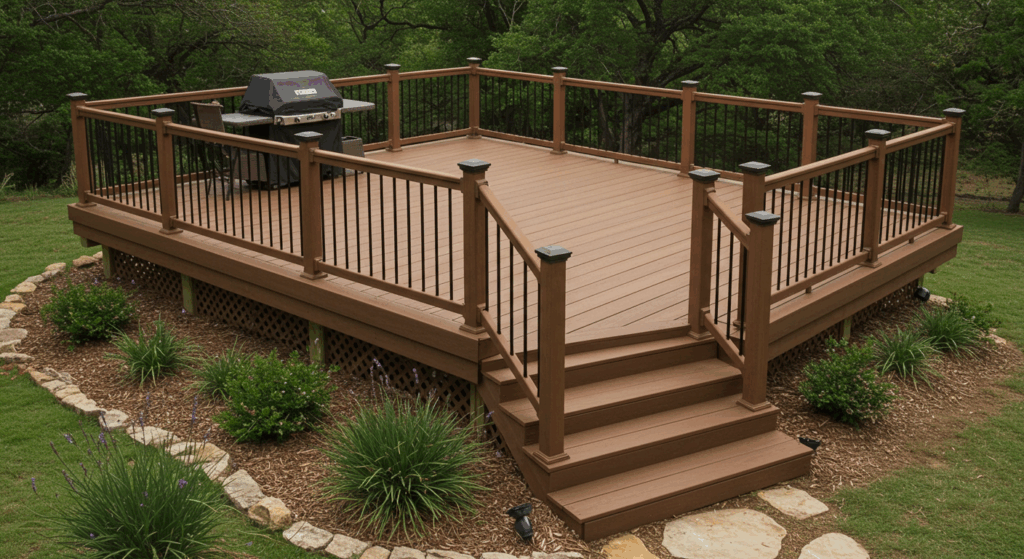When you invest in a Trex deck installation, you’re choosing one of the most durable, low-maintenance outdoor materials on the market. But even though Trex is engineered to handle tough environments, Austin’s unpredictable weather — from blistering summer heat to sudden thunderstorms, high humidity, and even hail — can put your outdoor space to the test.
In this comprehensive guide, we’ll break down everything you need to know to keep your Trex deck in top shape year-round, ensuring it stays beautiful, safe, and functional for decades to come. Let’s talk Trex deck maintenance.
Why Trex Is Built for Austin’s Climate
Austin homeowners know that Texas weather is no joke. The intense UV rays, rapid temperature swings, heavy downpours, and high humidity levels can wreak havoc on traditional wood decks. Fortunately, Trex’s composite material resists fading, warping, splintering, and moisture damage, making it ideal for Central Texas conditions.
Trex is made from 95% recycled materials, blending reclaimed wood fibers with durable plastic. This composite makeup allows it to outperform natural wood, offering superior resistance to mold, mildew, insects, and weather-related wear.
But “low-maintenance” doesn’t mean “no maintenance.” A little regular care will help extend your deck’s lifespan and keep it looking its best, no matter what Mother Nature throws at it.
How Trex vs. Wood Perform Across Austin’s Four Seasons
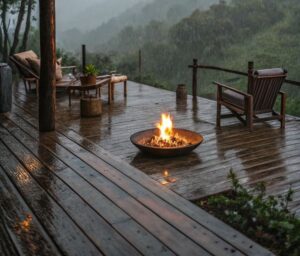
Austin’s weather doesn’t play by the rules. Between blazing summers, wet winters, windy springs, and crisp falls, outdoor materials here face constant challenges. To truly understand why Trex is such a popular choice, it’s worth comparing how both Trex composite and traditional wood hold up season by season.
Let’s break it down:
☀ Summer: Scorching Heat, UV Exposure, and Dryness
Austin’s summer challenges:
-
Daily highs often over 100°F
-
Intense UV rays
-
Prolonged drought conditions
-
Occasional violent thunderstorms
Trex Performance:
Trex was engineered to handle brutal summer sun. Thanks to its composite makeup, Trex resists UV damage much better than wood. It doesn’t fade or bleach out, even after years of direct sunlight. The boards also don’t dry out, crack, or splinter like wood because they don’t absorb moisture or lose essential oils.
Some homeowners worry Trex might get hot underfoot, but its lighter-colored options reflect heat better, and installing shaded pergolas or awnings reduces surface temperature further. Trex also resists warping during sudden afternoon downpours, maintaining its shape without swelling or buckling.
Wood Performance:
Natural wood, while beautiful, struggles in the summer. Under Austin’s sun, wood decks dry out rapidly, losing moisture that’s essential to keeping boards flexible. This leads to:
-
Splintering
-
Cracking
-
Warping or cupping
Even with regular staining and sealing, UV rays fade wood color quickly, turning it gray within a season or two if untreated. Heavy rains can further stress already-dry boards, causing sudden warping. Cedar and redwood hold up slightly better than pine, but all wood needs vigilant maintenance to survive Austin’s summers.
❄ Winter: Freezes, Moisture, and Temperature Swings
Austin’s winter challenges:
-
Occasional freezing nights
-
Moisture from rain or rare snow
-
Rapid temperature fluctuations
Trex Performance:
Trex’s composite nature means it expands and contracts uniformly with temperature swings, reducing the risk of cracks or gaps between boards. Importantly, it doesn’t absorb water, so it resists damage from freeze-thaw cycles — when moisture gets into material, freezes, and expands.
In winter, Trex maintains its structural integrity and color. You might want to sweep off debris like leaves or clear snow (if we get any), but you won’t need to worry about water soaking in and causing long-term damage.
Wood Performance:
Wood is porous — it absorbs water, and when temperatures drop below freezing, the water expands inside the boards. This can lead to:
-
Splitting or cracking
-
Loosened fasteners or nails
-
Warped or buckled planks
Even treated lumber is vulnerable, especially if sealants have worn down. Wet, frozen wood is also more prone to becoming slippery, creating a hazard for foot traffic.
🌸 Spring: High Winds, Pollen, and Storms
Austin’s spring challenges:
-
Strong winds
-
Severe thunderstorms
-
Heavy pollen
-
Quick weather changes
Trex Performance:
Spring in Austin can go from calm mornings to violent hailstorms by afternoon. Trex’s durability shines here, as it resists wind-blown debris, doesn’t dent or chip easily, and holds up well against hail impact. Its smooth surface makes it easy to rinse off pollen buildup with a hose, and because it’s mold- and mildew-resistant, you won’t see springtime moisture creating slippery, greenish patches on your deck.
Wood Performance:
Wood decks face several challenges each spring. High winds can tear up or loosen wooden boards, especially if fasteners are rusting. Hail can dent or split wood, while heavy pollen combined with spring moisture fosters mold or mildew growth. Without regular spring cleaning and resealing, wood decks can develop slippery, unsafe surfaces and begin rotting under the constant onslaught of wet conditions.
🍂 Fall: Leaves, Moisture, and Cooling Temps
Austin’s fall challenges:
-
Falling leaves and debris
-
Cooler nights, warm days
-
Increased rainfall
Trex Performance:
Trex is largely unaffected by fall weather. Leaves and twigs can simply be swept or rinsed off, and moisture from autumn rains won’t penetrate or warp the boards. Even as temperatures fluctuate, Trex’s material stays dimensionally stable, meaning it won’t loosen or crack as wood might when expanding and contracting.
Wood Performance:
For wood decks, fall can be a messy time. Fallen leaves trap moisture against the surface, encouraging rot or mildew. Without proper drainage, wood boards can become soggy, swell, and eventually decay. The cool nights and warm days of fall also test the flexibility of wooden boards, and if they’re already stressed from summer’s heat, they can start cracking or splitting under pressure. Regular raking, cleaning, and resealing are essential in the fall to keep wood decks healthy.
Summary Table: Trex vs. Wood Through Austin’s Seasons
| Season | Trex Highlights | Wood Challenges |
|---|---|---|
| Summer | UV-resistant, fade-proof, splinter-free, heat-manageable | Splintering, cracking, fading, warping under sun |
| Winter | Freeze-resistant, no water absorption, color stability | Cracking from freeze-thaw, water absorption |
| Spring | Wind and storm resistant, easy to clean, mold-resistant | Hail damage, mold growth, fastener loosening |
| Fall | Stable, easy leaf cleanup, resists rot | Leaf-trapped moisture, swelling, mildew, rot |
✅ Want help prepping your deck for the next season? Contact AHY for a seasonal inspection or maintenance check. We’re here to help you keep your outdoor space beautiful and functional, no matter what Texas weather throws your way!
Seasonal Maintenance Checklist
To maintain your Trex deck effectively, break your care routine into seasons:
Spring:
- Inspect for any winter damage, including debris buildup or minor surface scratches.
- Give the deck a thorough rinse to wash away pollen, dirt, and any mold or mildew.
- Check nearby plants or shrubs; trim anything that’s growing too close and may scratch or stain the deck.
Summer:
- Sweep regularly to remove dust and leaves, especially during dry, windy periods.
- Rinse the deck with cool water to remove dust and prevent heat buildup.
- Watch for barbecue grease or sunscreen spills; clean them promptly with soapy water.
Fall:
- Clear away fallen leaves, acorns, and other organic debris to prevent staining or mold growth.
- Inspect the deck surface for any signs of wear before winter.
- Ensure proper drainage around the deck to prevent standing water during winter rains.
Winter:
- Sweep off snow or ice gently using a soft broom or plastic shovel; avoid metal shovels that can scratch the surface.
- Avoid using rock salt or harsh de-icers, which can damage composite materials.
- Check that outdoor furniture or pots aren’t trapping moisture against the deck.
Cleaning Best Practices
Trex decks are incredibly easy to clean, but knowing the right techniques can make a big difference.
- Regular Rinsing: Every few weeks, rinse your deck with a garden hose to remove surface dirt, pollen, and debris.
- Soap and Water: For general cleaning, use warm soapy water (mild dish soap) and a soft-bristle brush. Scrub gently in the direction of the grain.
- Avoid Pressure Washers: While some Trex lines tolerate low-pressure washing, it’s safer to stick with a garden hose to avoid damaging the surface.
- Spot Clean Stains: For stubborn stains (like barbecue grease or spilled wine), use a commercial composite deck cleaner recommended by Trex, following the instructions carefully.
Protecting Your Deck from Austin’s Heat
Austin summers bring extreme UV exposure and heat, which can warm up any outdoor surface, including Trex decking. Here’s how to keep things cool:
- Choose Lighter Colors: If you’re planning a new deck, consider lighter Trex colors that stay cooler underfoot.
- Add Shade Features: Install pergolas, umbrellas, or shade sails to protect both the deck and your family from direct sun.
- Avoid Heat-Intensive Activities: Be mindful when using grills or fire pits; always use protective mats to prevent heat damage or grease stains.
Preventing Moisture & Mold Issues

While Trex is moisture-resistant, Austin’s high humidity and occasional torrential rains mean you should still take precautions:
- Ensure Proper Ventilation: Make sure there is good airflow under your deck to prevent trapped moisture.
- Clear Standing Water: After storms, sweep away pooled water to avoid slip hazards and mold growth.
- Clean Between Boards: Use a putty knife or thin tool to clear debris between deck boards, especially after heavy winds or storms.
Dealing with Storm Damage
Austin weather can turn on a dime, bringing hail, heavy rain, or strong winds. After a big storm:
- Inspect for Damage: Check for dents, scratches, or loose fasteners.
- Address Issues Promptly: Tighten loose screws or clips, and replace any damaged boards to prevent further issues.
- Remove Debris: Clear away fallen branches, leaves, or dirt to prevent moisture problems or staining.
Long-Term Maintenance Tips
Want to extend the life of your Trex deck well beyond its warranty?
- Use Protective Pads: Place rubber or felt pads under heavy outdoor furniture to prevent scratching.
- Avoid Harsh Chemicals: Never use bleach, ammonia, or oil-based cleaners on your Trex deck.
- Reseal Fasteners: Every few years, check hidden fasteners or screws to ensure they remain secure.
- Schedule Professional Inspections: Consider having a deck professional inspect your Trex deck every 3-5 years, especially if it sees heavy use.
Preparing for Resale Value
A well-maintained Trex deck can significantly boost your home’s curb appeal and resale value.
- Keep It Clean for Showings: If you’re selling, make sure the deck is spotless, staged with clean furniture, and free of clutter.
- Highlight Low Maintenance: Educate buyers about Trex’s long-term durability and low upkeep compared to wood.
- Show Off Upgrades: If you’ve added lighting, custom railings, or shade features, emphasize these extras in your listing.
Common Mistakes to Avoid
Even though Trex is tough, avoid these common maintenance errors:
- Don’t Use Power Washers at Full Strength: High pressure can damage the composite surface.
- Avoid Dragging Heavy Items: Lift furniture or planters instead of sliding them across the deck.
- Don’t Let Debris Sit: Leaves, dirt, or snow left for long periods can lead to staining or mildew.
Partner with Austin’s Trex Experts
Austin homeowners who want year-round peace of mind are increasingly choosing Trex over wood. While wood decks demand constant seasonal maintenance — staining in summer, sealing before winter, cleaning in spring, and raking in fall — Trex keeps life simple. A quick rinse or sweep keeps it looking fresh, and its resistance to environmental challenges makes it a smart, long-term investment.
Of course, some homeowners still love the authentic charm of wood and are willing to put in the time and effort to preserve it. But if you value durability, minimal upkeep, and lasting beauty through all of Austin’s wild seasons, Trex clearly comes out ahead.
If you want the ultimate peace of mind, work with local professionals like AHY who specialize in Trex installation, inspection, and replacement. Our team understands Austin’s climate, the unique challenges it brings, and the best strategies to keep your deck beautiful and functional.
We offer:
- Trex Deck Installation & Design
- Trex Fence Installation & Design
- Repairs & Upgrades
- Free Consultations & Estimates
Contact us today to keep your Trex deck investment protected, rain or shine.


